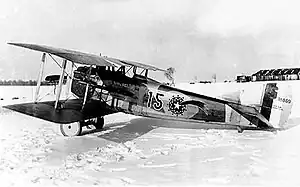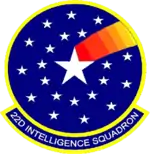22nd Intelligence Squadron
The 22d Intelligence Squadron (22 IS) is a non-flying squadron of the United States Air Force. It is assigned to the 691st Intelligence, Surveillance and Reconnaissance Group, Fort George G. Meade, Maryland.
| 22d Intelligence Squadron | |
|---|---|
 22d Aero Squadron SPAD S.XIII, Souilly Aerodrome, France | |
| Active | 1917–1946; 1965–1971; 1976–1979; 1993–present |
| Country | |
| Branch | |
| Type | Squadron |
| Role | Intelligence |
| Part of | Air Force Intelligence, Surveillance and Reconnaissance Agency |
| Garrison/HQ | Fort George G. Meade, Maryland |
| Engagements |
|
| Decorations | Air Force Outstanding Unit Award with Combat "V" Device Air Force Outstanding unit Award |
| Insignia | |
| 22d Intelligence Squadron emblem |  |
| 22d Observation Squadron emblem (approved 1 March 1924)[1][note 1] |  |
| 135th Aero Squadron emblem (approved 15 November 1918)[2] |  |
The 22 IS is one of the oldest units in the United States Air Force, its lineage and history consisting of two World War I Western Front combat squadrons.
- The 22d Aero Squadron was organized on 16 June 1917 at Kelly Field, Texas. A Pursuit (Fighter) squadron of the American Expeditionary Forces, it took part in the Somme Defensive; St. Mihiel offensive, and Meuse-Argonne offensive campaigns. The unit was demobilized after the war in 1919.
- The 135th Aero Squadron was organized on 1 August 1917 at Rockwell Field, California. A Corps Observation (Reconnaissance) squadron, it took part in the Somme Defensive; St. Mihiel offensive, and Meuse-Argonne offensive campaigns. It was re-designated as the 22d Observation Squadron in March 1921 as part of the permanent United States Army Air Service.[3][1]
The two units were consolidated in April 1937. During World War II, the squadron became part of Ninth Air Force in the European Theater of Operations (ETO) as a tactical reconnaissance squadron. During the Cold War, it was part of Tactical Air Command.[1][4]
Overview
The 22d Intelligence Squadron provides decisive information operations shaping the battle space environment. It tasks, conducts operations on, and provides effective organization, control, technical guidance, and support of signals intelligence (SIGINT) activities in support of the Department of Defense (DOD) and other authorized organizations as an integral part of the National Security Agency (NSA).[5]
The Squadron conducts Air Force airborne and ground operational and technical intelligence, analysis, training and dissemination missions at National Security Agency, providing 24-hour real time national level information collection and analysis to U. S. and allied combat commanders, unified and specified commands, National Command Authorities and other non- Department of Defense agencies.[5]
The 22 IS is specialized and consists of teams of intelligence professionals supporting global reach, focusing global power, and securing and maintaining information superiority by providing leadership and representation to ensure the proper placement and timely integration of qualified personnel into the National Security Agency (NSA), Directorate of Operations. The 22 IS sustains quality of life and ensures adequate training for all personnel to be able to meet Air Force and NSA peacetime and warfighting objectives. The 22 IS performs information operations through multiple sources for national, theater, and tactical customers.[5]
The 22 IS oversees administrative and logistical support of assigned flights within NSA, and provides operational support, in liaison with the 707 Intelligence, Surveillance, and Reconnaissance Group, to all squadron members involved in NSA activities. The Squadron coordinates with appropriate NSA elements within groups to present orientation briefings and support to supervisors of squadron members. It influences intelligence and communications computer systems security that is provided to the tactical warfighters, theater-battle managers, and national-level decision makers, as well as influencing analysis, production, and dissemination of near real-time intelligence in various products to unified and specified commanders, and the intelligence community.[5]
History
World War I
- see 22d Aero Squadron and 135th Aero Squadron for expanded histories of their World War I operations

Established as the 7th Aero Squadron in June 1917; redesignated 22d Aero Squadron later that month in an Air Service reorganisation. Trained with JN-4 Jennys in Texas, later receiving instruction in British aircraft in Toronto, Ontario, Canada with the Royal Flying Corps, until 19 October 1917, when it returned to Taliaferro Field. On 21 January 1918, it was shipped to Garden City, and shipped out on the RMS Adriatic (1907) on 31 January 1918. When it arrived in England, the squadron Flights (A, B, C) were split up amongst English squadrons, and used in bombing and observation missions.
In Europe, the 22nd and 135th Aero Squadrons fought in combat on the Western Front as fighter squadrons, flying French SPAD S.XIIIs (22d Aero) and British Airco DH.4s (135th Aero). The unit was finally reassembled on 24 June 1918 at Guînes, and went to (Issoudun). It remained in combat, moving to numerous airfields as needed along the front frequently as the ground situation required. On 7 July 1918, the unit went to Orly, and was retasked as a Pursuit squadron. On 16 August 1918, it was sent to Toul, and on 21 August 1918 started combat operations. It was then sent to Belrain on or about 20 September 1918 and remained there until after the armistice. After the November 1918 cease fire, remained in France until the spring of 1919 when was returned to the United States. 22d Aero was demobilized and inactivated in June 1919; 135th Aero remained as part of the postwar Air Service.
Inter-war period
After returning from France, most of the 135th Aero Squadron demobilized at Hazelhurst Field, Long Island, and returned to civilian life. A small cadre of the unit remained in the Air Service, and were assigned to Post Field, Oklahoma, and attached as an observation squadron, supplying aircraft for the United States Army Field Artillery School at Fort Sill and supported Army units at Fort Leavenworth, Kansas. Was moved to Maxwell Field, Alabama in late 1921 and provided reconnaissance for Army units in the IV Corps Area. Participated in the annual maneuvers of the 8th Infantry Brigade 1923–31, however continued to support Army units at Fort Bragg, North Carolina throughout the 1920s with a detachment assigned to Pope Field.
Re-designated as the 22d Observation Squadron on 25 January 1923. Pilots of the 22d Squadron’s detachment at Pope Field, North Carolina, mapped routes to Savannah and Macon, Georgia, and Louisville, Kentucky. So it went in order that all parts of the country might be covered.
Transferred in 1931 to Brooks Field, Texas supporting Army units in Texas. In 1937, the Army Air Corps consolidated the unit with the demobilized 22d Aero Squadron and giving the unit a second World War I lineage and honors. Supported Army units at Fort Sam Houston, Texas.
World War II
After the Attack on Pearl Harbor was assigned to Third Air Force in 1942, supporting Army units at Fort Polk, Louisiana in training maneuvers. Deployed to the Desert Training Center in Southern California in 1942 providing reconnaissance and helping to prepare Fifth Army ground forces for desert combat prior to the Operation Torch landings in French West Africa in November 1942. Later returned to North Carolina to support units at Fort Bragg; later Fort Campbell, Kentucky with flying observation missions.
In late 1944 was ordered to train for service overseas as a combat reconnaissance squadron Re-equipped with modern A-20, P-39 and P-40 fighters used as tactical reconnaissance aircraft. Trained under Third Air Force for battlefield tactical reconnaissance missions. Deployed to Nancy/Essey Airfield (Y-42), France in March 1945 as part of Ninth Air Force, later to Haguenau Airfield (Y-39), France in April flying tactical reconnaissance missions over Nazi Germany with P-51/F6 photo-reconnaissance aircraft in the closing stage of the war, supporting Allied ground forces (Primarily US Third Army) as part of the Western Allied invasion of Germany.
Returned to the United States after the German Capitulation in May. Conducted pilot training at DeRidder airfield Louisiana in May 1945 for missions in the Pacific theater, however never deployed due to Japanese Capitulation in September. Became part of the Continental Air Forces Third Air Force at Drew Field, Florida in August, being reassigned to Brooks Field, Texas in December. Demobilized throughout 1946, inactivated in August.
Cold War
Reactivated at Shaw AFB, South Carolina, 1971, not manned or equipped. Reactivated as an unmanned drone reconnaissance squadron at Davis-Monthan AFB, Arizona under Tactical Air Command in 1971 with the establishment of the 11th Tactical Drone Squadron on 1 July 1971 under the 355th Tactical Fighter Wing. The 22d Tactical Drone Squadron was a second drone squadron at Davis-Monthan, being activated and assigned to the 432d Tactical Drone Group on 1 July 1976; being its operational component.
Performed photographic reconnaissance to support tactical air and surface forces with tactical drones manufactured by Ryan Aeronautical. Used AQM-34L/M/V drones, DC-130 launch vehicles, and CH-3 recovery helicopters. The group conducted follow-on testing and evaluation of the AQM-34V model drone and the initial operational testing and evaluation and developmental testing and evaluation of the DC-130H "mother ship." The 432d also supported testing and evaluation of the BQM-34C drone at Hill AFB, Utah.
Support organizations included the 432d Field Maintenance (later Drone Generation) Squadron and 432d Organizational Maintenance (later Aircraft Generation) Squadron.
Both TDS were inactivated in 1979 due to budget restrictions; drone operations moved to Eglin AFB. Florida.
Aces
- Jacques Swaab: 10 victories
- Clinton Jones: 8 victories
- James Beane: 6 victories
- Arthur Raymond Brooks: 6 victories
- Remington Vernam: 5 victories[6]
Lineage
- 22d Aero Squadron
- Organized as the 17th Aero Squadron on 16 June 1917
- Redesignated 22d Aero Squadron on 20 June 1917
- Redesignated 22d Aero Squadron (Pursuit) on 16 August 1918
- Demobilized on 16 June 1919
- Consolidated with the 22d Observation Squadron on 17 April 1937
- 22d Intelligence Squadron
- Organized as the 135th Aero Squadron on 1 August 1917
- Redesignated 135th Aero Squadron (Corps Observation) on 19 July 1918
- Redesignated 135th Aero Squadron on 29 May 1919
- Redesignated 22d Squadron (Observation), 14 March 1921
- Redesignated 22d Observation Squadron on 25 January 1923
- Consolidated with 22d Aero Squadron (Pursuit), on 17 April 1937
- Redesignated 22d Observation Squadron (Medium) on 13 January 1942
- Redesignated 22d Observation Squadron on 4 July 1942
- Redesignated 22d Reconnaissance Squadron (Bombardment) On 2 April 1943
- Redesignated 22d Tactical Reconnaissance Squadron on 11 August 1943
- Inactivated on 31 August 1946
- Activated on 1 December 1965
- Inactivated on 15 October 1971
- Redesignated 22d Tactical Drone Squadron
- Activated on 1 July 1976
- Inactivated on 1 April 1979
- Redesignated 22d Intelligence Squadron
Assignments
- As 22d Aero Squadron (World War I)
|
|
- As 135th Aero (later 22d Observation) Squadron
|
|
- After Consolidation
|
|
Stations
22d Aero Squadron (World War I):
|
|
135th Aero (later 22d) Squadron:
|
|
Consolidated squadron:
|
|
Aircraft
|
|
References
Notes
- Explanatory notes
- Based on emblem approved by AEF on 15 November 1918. Cross and Cockade Journal, Vol. V, No. 2, p. 145.
- Citations
- Maurer, Combat Squadrons, pp. 117–119
- Cross and Cockade Journal, Vol. V, No. 2, p. 145
- Gorell, Series "E", Volume 5,
- Rogers,
- Factsheet: 70th Intelligence, Surveillance and Reconnaissance Wing
- American Aces of World War I. p. 86.
- Army Air Service Order of Battle 1919–1941
- Hyatt, SSG A. J. (27 June 2017). "June 16, 2017: 22d Intelligence Squadron celebrates its Centennial". 70th ISR Wing Public Affairs. Retrieved 24 May 2020.
Bibliography
![]() This article incorporates public domain material from the Air Force Historical Research Agency.
This article incorporates public domain material from the Air Force Historical Research Agency.
- Clay, Steven E. (2011). US Army Order of Battle 1919–1941 (PDF). Vol. 3 The Services: Air Service, Engineers, and Special Troops 1919–1941. Fort Leavenworth, KS: Combat Studies Institute Press. ISBN 978-0-98419-014-0. LCCN 2010022326. OCLC 637712205. Archived from the original (PDF) on 27 September 2013. Retrieved 16 October 2012.
- Franks, Norman; Dempsey, Harry (2001). American Aces of World War I. Osprey Publishing. ISBN 978-1-84176-375-0.
- Gorrell, Col. Edgar S. (1974). History of the American Expeditionary Forces Air Service, 1917-1919. Series E: Squadron Histories. Vol. 5 22d-24th Aero Squadrons. Washington, DC: National Archives and Records Service, General Services Administration. OCLC 215070705.
- Maurer, Maurer, ed. (1982) [1969]. Combat Squadrons of the Air Force, World War II (PDF) (reprint ed.). Washington, DC: Office of Air Force History. ISBN 0-405-12194-6. LCCN 70605402. OCLC 72556.
- Rogers, Brian. (2005). United States Air Force Unit Designations Since 1978. Hinkley, UK: Midland Publications. ISBN 1-85780-197-0.
- "World War I Aero Squadrons". Cross and Cockade Journal. Society of World War I Aero Historians. 5 (2). 1964.

